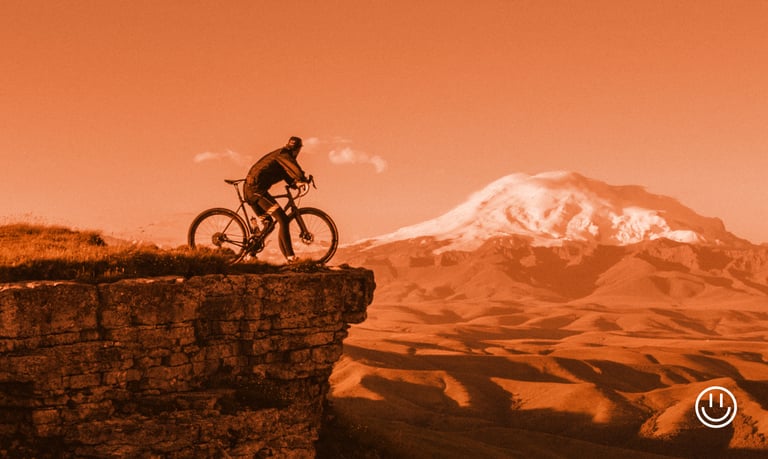Pedaling Towards Fitness: Your Complete Guide to Cycling
SPORT


Cycling is an invigorating and eco-friendly form of exercise that offers numerous health benefits, from improved cardiovascular health to enhanced mental well-being.
Pedaling Towards Fitness: Your Complete Guide to Cycling
Introduction
Cycling is an invigorating and eco-friendly form of exercise that offers numerous health benefits, from improved cardiovascular health to enhanced mental well-being. Whether you're cycling for fitness, commuting, or recreation, this guide covers all aspects of cycling, including the different types of cycling, how to get started, safety precautions, alternative exercises, essential gear, and frequently asked questions.
What is Cycling?
Cycling involves riding a bicycle for various purposes such as transportation, recreation, or sport. It is a low-impact aerobic exercise that is suitable for people of all ages and fitness levels.
Types of Cycling
1. Road Cycling: Riding on paved roads, often for long distances and at high speeds. It's popular for fitness, commuting, and competitive racing.
2. Mountain Biking: Off-road cycling on trails, rough terrain, and mountains. It requires a sturdy bike with good suspension.
3. Commuter Cycling: Using a bike for daily transportation, such as getting to work or running errands.
4. Touring: Long-distance cycling trips that often last several days or weeks, combining cycling with travel.
5. Cyclocross: A type of racing that takes place on varied terrain including grass, dirt, and pavement, often featuring obstacles.
6. Track Cycling: Racing on a velodrome track, typically an oval-shaped, banked track.
How to Start Cycling
Getting Started for Cycling
1. Choose Your Bike: Select a bike that suits your intended type of cycling. Road bikes, mountain bikes, hybrid bikes, and commuter bikes all have different features tailored to specific uses.
2. Safety Gear: Always wear a helmet. Consider additional protective gear like gloves and padded shorts for comfort.
3. Basic Maintenance: Learn how to perform basic maintenance tasks such as checking tire pressure, lubricating the chain, and fixing a flat tire.
Basic Techniques
1. Mounting and Dismounting: Practice getting on and off your bike smoothly.
2. Pedaling: Maintain a steady cadence. Aim for a cadence of 70-90 revolutions per minute for most riding.
3. Braking: Use both brakes to stop smoothly. The front brake provides more stopping power, but use it carefully to avoid going over the handlebars.
4. Shifting Gears: Shift to lower gears when climbing hills and to higher gears on flat terrain. Anticipate changes in terrain to shift smoothly.
5. Riding Posture: Keep a relaxed but firm grip on the handlebars. Your elbows should be slightly bent, and your back should be straight but relaxed.
Precautions for Cycling
1. Visibility: Wear bright clothing and use lights or reflectors to ensure you're visible to motorists, especially at dawn, dusk, or night.
2. Helmet Fit: Ensure your helmet fits properly. It should sit level on your head and not tilt backward or forward.
3. Road Safety: Follow traffic rules, signal your turns, and stay aware of your surroundings. Ride in the bike lane or on the right side of the road.
4. Hydration and Nutrition: Stay hydrated and carry snacks for long rides. Drink water regularly, even if you don't feel thirsty.
5. Know Your Limits: Start with shorter rides and gradually increase your distance and intensity to avoid overuse injuries.
Alternatives to Cycling
If cycling isn't suitable for you, consider these alternative exercises:
1. Running: A high-impact cardio workout that improves cardiovascular fitness and strengthens the lower body.
2. Swimming: Provides a full-body workout with minimal impact on the joints.
3. Walking: A low-impact exercise that is easy on the joints and can be done anywhere.
4. Elliptical Training: Mimics the motion of cycling without the impact, offering a good cardiovascular workout.
5. Rowing: A low-impact, full-body workout that builds both cardiovascular and muscular strength.
Essential Cycling Gear
1. Helmet: Protects your head from injuries. Always wear a helmet, regardless of the distance or terrain.
2. Bike Lights and Reflectors: Essential for visibility, especially in low-light conditions.
3. Cycling Apparel: Moisture-wicking clothing, padded shorts, and gloves for comfort and protection.
4. Water Bottle and Holder: Stay hydrated by carrying water on your rides.
5. Repair Kit: Includes a spare tube, tire levers, a pump, and a multi-tool for on-the-go repairs.
6. Bike Lock: Secure your bike when you leave it unattended.
FAQs
Q1: How often should I cycle to see fitness benefits?
A1: Aim for at least 150 minutes of moderate cycling per week, which can be broken down into 30-minute sessions five times a week.
Q2: What type of bike should I buy?
A2: It depends on your intended use. Road bikes are great for speed and long distances, mountain bikes for off-road trails, and hybrid bikes for a mix of both.
Q3: How can I prevent soreness after cycling?
A3: Ensure your bike is properly fitted to your body, use padded shorts, and stretch before and after rides. Gradually increase your riding time and intensity.
Q4: Is cycling safe for people with joint issues?
A4: Yes, cycling is a low-impact exercise that is gentle on the joints. However, consult with a healthcare provider if you have specific joint concerns.
Q5: Can I lose weight by cycling?
A5: Yes, regular cycling combined with a healthy diet can help you lose weight by burning calories and improving your metabolism.
Conclusion
Cycling is a versatile and enjoyable form of exercise that offers numerous health benefits and can be easily integrated into your daily routine. Whether you're riding for fitness, fun, or transportation, the key is to start slowly, stay safe, and enjoy the ride. So, hop on your bike, explore new routes, and pedal your way to better health.
---
For more tips, training plans, and cycling-related content, subscribe to our blog and follow us on social media.
- Facebook:
- Twitter: [@....] #CycleWorld
- Instagram:
### Contact Us
Have questions or suggestions? Contact us at info@bukars.com
---
This comprehensive guide covers all aspects of cycling, making it a valuable resource for beginners and experienced cyclists alike.
